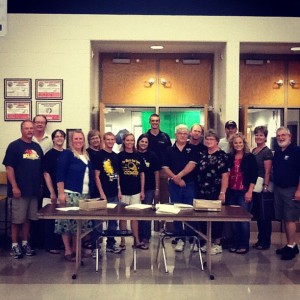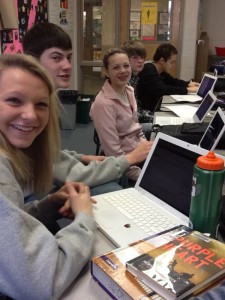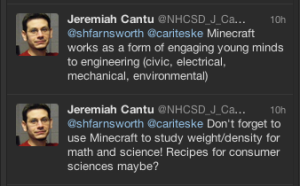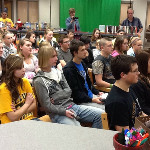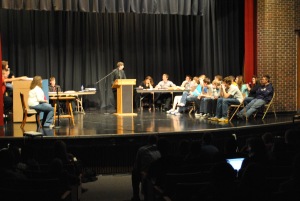Classroom Discussion Strategies
Classroom Discussions play an important role in student learning. It engages students, allows them to practice important life skills and is also a form of assessment. I rely on these interactions to help me gauge student understanding of topics we are studying. The following are a few of my favorite, and more unique, discussion strategies. Many of these ideas have been borrowed and modified for my own classroom.
First Things First –
Establish classroom guidelines for discussions. Ask students for input; they always have great ideas. Limit guidelines to 5 or fewer and use accessible language for all students. Here are my guidelines, along with brief explanations:
1. No Hands – when discussing, students must negotiate their own time and not speak over each other. They are speaking to EVERYONE in the classroom, not just to me.
2. Stay on Topic – although I love when discussions grow organically, if Ophelia’s death quickly turns to school gossip I step in and refocus the group if a student hasn’t already.
3. Disagree with the Comment, DO NOT attack the person – Differing opinions makes life interesting and classroom discussions fruitful.. One of the most difficult things for students to understand is another student’s TRUTH is just as right and as strong as their own TRUTH.
4. No yelling, swearing, throwing chairs, etc. – I teach AP Literature. Our discussions often lead to religion, politics, gender, etc. and can get heated. These rules are necessary for the safety and climate of the classroom.
5. Ends at the Bell – nothing excites me more than when students are still talking about the class as they walk out the door, toppling into lunchroom conversations or is brought up at home with parents; but, students are not to use anything that was said in the discussion in a negative way, wether in a different class or on the athletic field. We all agree to disagree.
Strategies
1. Fishbowl Tap-out 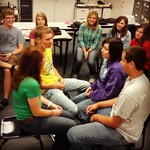
*4 chairs placed in the middle of the room, while all students form an outside circle around the center group, thus forming a “fishbowl” effect.
*The 4 students sitting in the middle are the only ones allowed to speak. They are having a discussion with each other about topics at hand or what they read.
*If an outside circle student wishes to speak they must “tap-out” (on the shoulder) one of the 4 people. That person must stand and move to the outside circle. There is no refusing to leave once tapped-out.
*Students on the outside can be listening, backchanneling on a TodaysMeet, or taking notes on paper.
TIPS – Students should try to be in the “hot seat” at least once during the discussion, allow students 2 min. minimum before being tapped out, teacher may have to ask a question if discussion is stalling (otherwise they are a silent observer as well)
2. Body Voting 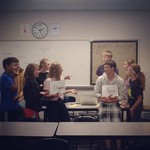
*Provide students with a list of statements. Have them silently go through each one marking if they “Agree” or “Disagree”.
*Designate opposite areas in the classroom as “Agree” and “Disagree” zones
*Teacher reads the statement and students move to the area that represents their response.
*Discussion can ensue in a team-like fashion.
TIPS – This strategy takes up a lot of time, have students mark on their paper the top 3 or 4 statements they would like to discuss. Give students one minute to organize thoughts and points as a group before starting discussion. Make students choose a side, there is no neutral.
3. SSC (Small Silent Collaboration)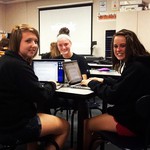
*Divide students into small groups – no more than 4 per group works best.
*Have one student create a gdoc or typewithme and share with the group members AND the teacher.
*Students silently type important topics from their reading, questions they had, surprises from the passage, etc.
*Teacher monitors all group writing noting important discussion topics found in each.
*After a designated time, students discuss as a large group. The teacher has all the student- driven discussion topics in hand.
TIPS – Typewithme allows students to join under any name, be careful in large groups. This strategy allows every student to have a “voice” which is unique for the teacher to see.
These strategies are a few of the more “unique” ones I use in my classroom. They are also the most effective in engaging students and encouraging participation!
Our “Edventure” into Standard Based Grading
Last year a couple teachers at BCLUW decided to implement Standard Based Grading (or a version of it) in their classrooms. Over the past year and throughout the summer, a small group of staff members, including myself, continued the learning. During one of the early PD days this year, a meeting was held for all those interested in Standard Based Grading. The following is a glimpse into the information gained at the meeting in the form a of an email sent to all staff…
“Last Friday a group of us met in the library to discuss Standard Based Grading. Many of us are at different levels of implementation, some are implementing in multiple classes while others are considering a unit to try it out on. What we all agreed upon was that Standard Based Grading made sense to us as teachers and as parents. I am sure we will form some sort of weekly or biweekly meeting in the near future, but in the meantime, we wanted to share some information that we agreed upon.
1 2 3 4
BCLUW Behavior Expectations
Student will:
Arrive to class on time
Come to class prepared
Complete work by due date
Consistently show effort
Use class time efficiently
Work well with others
Show respect to others and the school environment
3. Let us know if you have any questions. We will send out an email about our next meeting. Working together will help make these growing pains manageable. Plus, Standard Based Grading fits beautifully with PLCs, as it gives specific areas to address! “
I will update this blog with our progress. I would also like to mention, along with a dedicated staff and supporting administration, Matt Townsley and Russ Goerrend have been tremendous supports throughout this learning!
4 Conditions to Improve Success of 1:1 Initiatives
I have been asked many times what one should consider to aid in a successful 1:1 Initiative. The following is a list of the top 4 conditions, I believe, helps to ensure this success:
1. Sustained and High -Quality Professional Development – Provide PD that is research-proven, as well as data-driven by student needs. Allow time for sharing and collaboration throughout the year. While PD may contain apps and tools, focus should remain on pedagogy and curriculum. Apps and tools should never be pushed upon staff or mandated that ALL teachers use them in their teaching. Allow teachers to grow at their own rate, some may be more skilled/comfortable than others at tech integration in their curriculum.
2. Climate of the Building – The climate and culture of the building should support risk-taking without punishment and places trust in students and teachers. Administration should be fully aware that some things will not always work exactly as planned, but teachers who think outside of the norm or want to try something new in the classroom should not live in fear of being punished for a lesson that fails. Finally, beware of over-blocking and denying access to teachers and students. Trust in students and staff to utilize what works best for their curricular areas.
3. Infrastructure – If the technology doesn’t work in all areas of learning (in a building) it loses it’s potential and causes frustration. Also, when the comfort level with technology use grows, you will see multiple devices being used in learning. Students and staff will bring and want to use phones, ipods, and other personal devices along with their laptops. Is your building ready to support all of these devices?
4. Focus – Finally, technology will continue to advance, apps will become obsolete as others take their place; remember to make curriculum and pedagogy the main focuses. Utilizing technology in the classroom should not be a separate event, technology should be infused naturally because it is the best option available. Make sure the tech is relevant to learning and their lives, easily replicable for student use and applicable to other areas of curriculum and life.
15 Teacher Tips to Help Students Finish the Year Strong
Last week I was contacted by Laura McMullen, a reporter for the U.S. News and World Report , who wanted to interview me the following day about tips I had for teachers to finish the year strong. She explained that she had searched for “high school teachers” on Twitter and my account popped up. She checked out my tweets and blog (a teachable moments for my students) and decided I would be perfect for the article she was writing.
On Monday, the article came out – “Three Tips for Teachers to Help Students Finish the Year Strong” – which combines a few of the tips and examples that I gave to her. During the time I initially received the first email I was collaborating with my friend Tim Hadley, a Social Studies teacher at Pekin High School. He agreed to act as my sounding board as I created a list of tips. Tim also graciously added a few of his own tips to the document. I thought I would share the complete list with all readers…
1. Make a list of goals/objectives you wish to have students meet before the end of the year, prioritize them, and post in the classroom.
2. Chunk larger assignments into smaller sections; each section having due dates. This helps with procrastination and students waiting until the last minute to finish work.
3. End of the year is a great time to invite in speakers relevant to content studying into your classroom, either physically or virtually.
4. Give students choice. How do they want to demonstrate their learning?
5. Take advantage of the nice weather – reading, writing, geocaching, science experiments. Can your classroom be mobile and outdoors?
6. Provide an audience for your students projects, writing, etc. other than yourself.
7. Remain consistent with the routines and rules established at the beginning of the year.
8. Collaborate – get your class connected with students who are studying the same thing.
9. Reflect on the year and invite students to do the same; collecting responses to what they have learned, skills they have gained, least favorite and most favorite activities.
10. Spiral review- Connect prior learning from throughout the year with what you are doing currently and have students predict what they will learn about to the end of the year.
11. Don’t fight distractions, feed them. Tie lesson plans into summer plans. Have a student taking a trip? Talk about the places they will go or have them plan the ultimate summer vacation.
12. Get students active. Plan a service project for your community in which students can give back to their community.
13. Talk about the future. Have students give input about the year and the course of study they have been engaged in. Ask them for advice about what and how should be taught to incoming students.
14. Create a classroom survival guide. When students are reflecting on the course, have them create a short survival guide for next year’s students on what they can expect from the course.
15. With the ending of a school year comes new beginnings. Have students create goals and aspirations for what is next in their lives
Please add your list of tips below!
Minecraft, for Educational Purposes
Lately there has been a buzz in education about gaming as an aid to learning. While many educators are unsure of applicable roles in curriculum areas, students have definite ideas of how they can use gaming, more specifically Minecraft, to demonstrate their learning. Working in a 1:1 environment has given students opportunities to create remarkable multimedia projects, and being a seasoned 1:1 school, students at BCLUW tailor their learning and projects to fit their areas of interests and passions.
Meet Jarrett – a sophomore at BCLUW. As a freshmen he would amaze me with his stop-animation videos. He has a love of video games, like the normal 15 year old, and a passion to create. I knew Jarrett has used Minecraft in a few of his classes, History and English. Likewise, students at BCLUW have used Minecraft in many other curricular areas.
So what is Minecraft? Simply put, Minecraft is a virtual world where people build, explore, engage in battle. This survivor game is one where players use the environment to sustain life. Although that is the main focus of the game, gamers have been finding several new uses for Minecraft: architecture, computer programming, a hobby, and of course for EDUCATION.
Here is an example of Jarrett’s work. It is a virtual tour of Egypt that he researched, designed, built, and PRESENTED. This project was one he proposed to his history teacher in place of the other assignment.
Jarrett’s ideas for Minecraft Projects:
Science – Virtual demonstration of atom combining
Math – Electric Wiring
English – Virtual demonstration of grammar reviews
History – Reconstructing buildings
Spanish – Language selector in Minecraft to aid in learning
Art- Pixel art
Music – Create your own music, (there are instruments you can use in Minecraft)
___________________________________________________________________________________
Here are additional examples educators have been sharing with me. Please add your ideas in the comment section or tweet me!
Considerations for Designing an English Curriculum in a 1:1 Setting
Yesterday I completed (and passed) the oral exam needed to obtain my M.A. in English from UNI (now all I have left is the research paper!). My focus was on the confluence of our school implementing a 1:1 Laptop Program and my studies in graduate school which caused me to redesign current curriculum. During the conversation I verbalized important components of an English classroom in a digital age. This list helps to frame my curriculum:
1. Focus on the solid foundations and theory not the tool or application.
2. Students need to be critical thinkers, understanding content/messages in all literacies .
3. Reader is at the center of the text – only when meaning from text can be applied to self does it become important and relevant.
4. Students work within the cannon of the English language not outside of it.
5. Literacy is the heart of education.
6. Reading and writing are dichotic not separate entities.
7. Writing as a form of learning and reflection.
8. Communicate effectively in written, verbal, or multimedia forms for pleasure, education, and professional reasons.
9. Not all writing is complete or publishable, most is not
10. The art of response, how to respond effectively.
11. Understanding communication in multiple literacies and how to use different mediums to share their voice is essential part of being a productive citizen.
12. How to use technology to access information, connect, collaborate, create, and publish.
When focus is shifted to curriculum design with the aid of technology instead of a focus on tools and applications, student learning is framed within the essential skills of a curricular area not a set of tools that becomes outdated quickly.
References – Rosenblatt, Elbow, Atwell, NWP, Cope and Kalantzis
BCLUW High School Named Apple Distinguished School
Mid February, staff and students received a surprise in the form of an assembly during the last period of the day. When everyone had taken their seats, it was announced that BCLUW High School was named an Apple Distinguished School. BCLUW is one out of 56 schools across the nation to receive this award.
Tony Gunter, an Apple Executive, presented the award citing all of the evidence that makes BCLUW a worthy choice.
The following is a brief description of the award and qualifications needed to be named:
Schools nominated by Apple for designation as an Apple Distinguished School must demonstrate Apple’s highest vision of a successful 21st century learning environment, a strong relationship with Apple, and a willingness to do outreach activities. The specific manifestations of these qualities include:- School demonstrates “best practice” qualities of 21st century learning environment;
- Visionary leadership;
- An infrastructure (IT) that supports a blended learning environment;
- Engaging teaching and learning methods that capitalize on the qualities of today’s students who are mobile, collaborative and creative;
- One-to-one access to portable computers and/or mobile access devices (iPod or iPad) for all teachers and students;
- Evidence of ongoing professional development;
- A systematic approach and ongoing process for evaluation and assessment of results for education improvement and sustainability.
Buddy Day Spring 2012
 On March 1st, BCLUW High School students hosted a buddy day with their elementary friends focused on Dr. Seuss’s birthday and Read Across America Day. Each high school room chose a different Seuss book to have as the focus for their room. I chose “Oh The Places You’ll Go” – one of my all-time favorites.
On March 1st, BCLUW High School students hosted a buddy day with their elementary friends focused on Dr. Seuss’s birthday and Read Across America Day. Each high school room chose a different Seuss book to have as the focus for their room. I chose “Oh The Places You’ll Go” – one of my all-time favorites.
While eating our lunch, I shared the book through my Apple tv and ipad app which allowed students to listen and view an animated version of the story. Many of Dr. Seuss’s books are apps! After lunch, each buddy pair chose a section of the text to illustrate. With the help of their high school buddies, the second graders chose parts of the sections to read aloud for the imovie we were going to create. Applying a number of different activities to the piece with a variety of learning styles targeted increased learning, connection, and engagement. Students were listening, reading, drawing, and speaking all in one activity. We worked on fluency and pronunciation of the words to prepare for the taping of their part.
The following imovie was created from the students’ work and voices.
On a side note, and an idea from Mary Ascher, the second grade class is actually that of my son’s, and so I am going to save all of their drawings, writings, and videos and give to them for senior gifts.
“You Never Know Unless You Ask” – Skype with Poet Taylor Mali
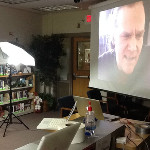 As a bell ringer during the poetry unit, I share with students one of my favorite poems. This helps to showcase different poets, forms, poetic devices, etc. Tuesday began with Taylor Mali’s “What Teachers Make” and a few other poems of his. The students fell in love with his boldness and play on words. He was a poet that they immediately connected with; speaking about school, relationships, typos…
As a bell ringer during the poetry unit, I share with students one of my favorite poems. This helps to showcase different poets, forms, poetic devices, etc. Tuesday began with Taylor Mali’s “What Teachers Make” and a few other poems of his. The students fell in love with his boldness and play on words. He was a poet that they immediately connected with; speaking about school, relationships, typos…
Throughout the day I noticed tweets to Mr. Mali from my students and much to my surprise he responded back to them. One of my students (I have labeled the “Queen of Social Media”) suggested he skype in with our class. We were all shocked and pleased when Mr. Mali agreed, stating to the student, “You never know unless you ask.”
Mr. Mali skyped with the students the following week. He spent time answering questions, inspiring students, and connecting with the kids. At the end, as a surprise, he sent them all a copy of his poem, “How Falling in Love is Like Owning a Dog” and recited it for them. A memory that we all reflect upon fondly.
Top Things Students Learned:
1. Poetry is COOL!
2. Twitter and other Social Media connects you with experts/world.
3. You don’t know unless you ask…
The next day the students were abuzz talking about skyping with Mr. Mali weekly, other people they wanted to skype with, understanding the power of technology to connect them to the world! This experience is one they will never forget, and they joke about telling their own children one day how they met Taylor Mali.
One of the highlights of my career!
Cross-Curricular, Project Based Learning: BCLUW Mock Trial
For the past five years, on the day before Thanksgiving break, the BCLUW senior class holds a Mock Trial as a culminating project at the end of a cross-curricular unit designed by myself (English) and Josh Ehn (Social Studies). This unit is designed to provide students an understanding of how our legal system works, as well as job prep skills. The government side of the project is taught by Mr. Ehn who also decides the roles each student will play and the court case to be tried. Students interview for positions from judge to jury members highlighting the skills and qualifications they have gained in high school that makes them the best candidate.
In English class, students create resumes based on real information, a necessity for graduating seniors. They also learn the fine art of writing a letter of application in hopes that their words and experience stands out in order to receive an interview. Finally, with the help of teachers and community members, each student is given a time and location for an interview.
This is a fantastic Project Based Learning example that helps blend learning from different departments. Students are challenged to express their skills on the resume, and the interview provides much needed experience with a bit of added pressure. We want to thank the following community members for donating their time to support BCLUW students: Shane Tiernan, Darla Ubben, Doug Benjamin, Denise Hoy, Mike Payne, and Jayne Katzer. It was another successful trial, the students had fun, and the defendant was found GUILTY… Next year we are looking for challengers, any school interested?
